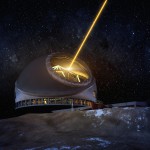While it is true that TMT could be located at another site, no site would be quite as good as Mauna Kea.
Astronomers measure the quality of a site in several ways, one of the most important is simply called ‘seeing’. This is a measure of atmospheric distortion, the amount of turbulence in the atmosphere above the telescope that distorts or blurs the image. In short it is a measure of how much stars twinkle at the site.
Seeing is measured in terms of the smallest discernible detail in arcseconds. A good site will have seing of less than one arcsecond. The best Chilean sites have seeing that averages around 0.7 arcseconds at best. Mauna Kea can have seeing that averages around 0.4 arcseconds when it is good, roughly twice as good as Chile.
Only one other site on the planet routinely offers better seeing… South Dome Antartica, a good site, but one with a host of other problems… Six months of sunlight, with much of the dark winter featuring heavy cloud cover and raging storms. Never mind horrible access issues and a couple miles of ice over the site.
One measure of quality where Chile surpasses Mauna Kea is in low humidity. Water vapor in the air blocks some wavelengths of light from reaching a telescope on the surface. In this respect Mauna Kea is good, Chilean sites are superb. This is not as much of a concern in the optical and infrared where TMT is designed to operate, thus seeing is much more important in choosing a site for TMT.
It is also true that TMT will be equipped with an adaptive optics system that can improve the seeing of any given site on the planet. What many do not understand is that adaptive optics is not perfect and only improves upon an already good site. A mediocre site plus AO is good. A site with excellent seeing plus AO is superb.
It is true that TMT could be built in the Canary Islands or one of the other sites that was studied, but nowhere will yield the quality of data available at Mauna Kea.
Result: Partly True



It’s worth noting that the center of the Milky Way is not observable from the Canary Islands, but it is from Hawaii. A huge research area for TMT would be lost if it moved to there.
This is simply not true. If you read the TMT siting committee’s peer-reviewed papers on selecting the site, you will find the following:
“All equipment was calibrated and characterized carefully before deployment to the candidate sites, where it operated for 2.5 to 5 yr.The results show that all candidate sites are excellent and are clearly among the best ground-based telescope sites on Earth.They also show that not a single site is perfect or is the best (or worst) in all parameters. This is, of course, a welcome outcome,as it means that the selection of candidate sites was successful and that the final site selection can safely also take into account other considerations, without compromising the expected scientific output of TMT.”
Schöck, M., et al. “Thirty Meter Telescope site testing I: overview.” Publications of the Astronomical Society of the Pacific 121.878 (2009): 384.
In other words, there are at least five different sites where the TMT would work just as well from a scientific basis and Mauna Kea was selected based on “other considerations” and not just because of its ability to see.
Taking a statement like that out of context of the report is interesting as it shows just how much of a political document the site report was, not which sites were actually better.
Exactly how is it “out of context”?
If you are claiming that the peer-reviewed paper was not objective, then why should we trust the TMT to do any honest science at all?
Site selection is highly political as we well know. While the text of the report has some notable pleasantries that read “all the sites were great” the real answers are in the numbers and data… For the types of science TMT will be doing, Mauna Kea is the best site.